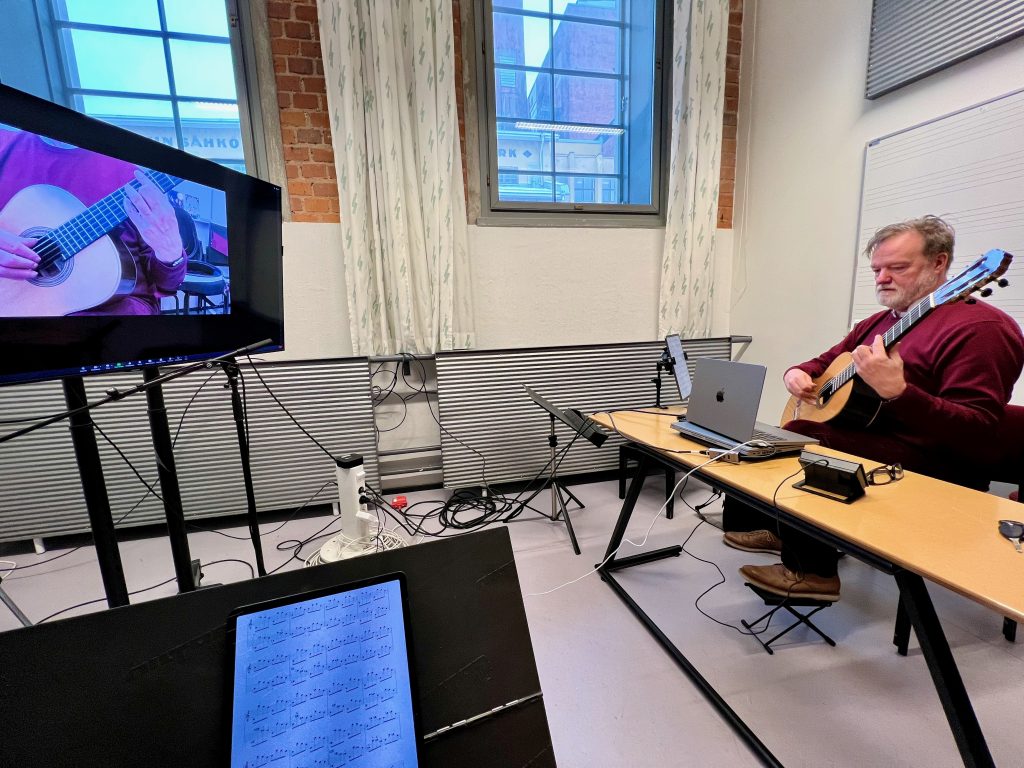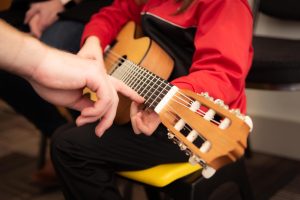Omien musiikkiopintojen edistymisen tarkastelu mobiilipelin avulla motivoi nuoria enemmän kuin perinteinen taulukkomuotoinen taitojen edistymisen seuranta. Olen tehdyt asiaa koskevan tutkimuksen…
Tekijät | Authors

Music Education in Finnish Higher Education today – an Overview
This article is an overview of the current state of music education in Finland. The focus in this paper is on the higher education of instrumental and perceiving music studies, not on the training of music teachers in schools. The aim of this article is to create ground to clarify the roles of two different education providers, the Sibelius Academy of the University of Arts and the eight Degree Programmes of Music in the Universities of Applied Sciences in different locations in Finland. Vocationally-oriented universities are called differently according to tradition in different countries: Polytechnic, Praxis oriented UAS, Fachhochschule in Germany, and so on. In this article, it is called the University of Applied Sciences, later UAS.
The larger context of the study is to create background for curriculum design, and the use of digitalization in order to tackle the needs of changing working environment and society. The conclusion of the paper provides some suggestions.
The higher education (HE) in Finland is based on dual model:
- Scientific universities practice science and instruction based on it is provided. Universities provide lower and higher university degrees, as well as postgraduate scientific degrees, such as licentiate and doctoral degrees.
- The vocationally-oriented universities of applied sciences improve working and economic life. They offer training that meets professional and regional needs. In addition to a Bachelor degree, a Master’s degree can be obtained in them.
Although the paths are distinct, student movement between sectors is possible after completing a lower university degree.
In the Universities Act, 2009, at Section 2, the Mission is stated as follow:
”The mission of the universities is to promote independent academic research as well as academic and artistic education, to provide research-based higher education and to educate students to serve their country and humanity at large. In carrying out their mission, the universities shall promote lifelong learning, interact with the surrounding society and promote the social impact of university research findings and artistic activities.
The universities shall arrange their activities so as to ensure a high international standard in research, artistic activities, education and tuition in conformity with research integrity.” (The Ministry of Education and Culture in Finland, Universities Act, 2009.)
In the Universities of Applied Sciences Act, 2014, at Section 4, the Mission is stated as follow:
”The mission of universities of applied sciences is to provide higher education for professional expert tasks and duties based on the requirements of the world of work and its development and on the premises of academic research and academic and artistic education and to support the professional growth of students.
The mission of universities of applied sciences is also to carry out applied research, development and innovation activities and artistic activities that serve education in universities of applied sciences, promote industry, business and regional development and regenerate the industrial structure of the region. In carrying out their mission, universities of applied sciences shall provide opportunities for continuous learning.” (The Ministry of Education and Culture of Finland, Universities of Applied Sciences Act, 2014.)
In music education there are two different actors:
- The Sibelius Academy of University of Arts is university.
- Vocationally-oriented Universities of Applied Sciences have eight degree programmes in music.
To get started with this topic, it is necessary to understand the variety of research orientation of polytechnic university of applied sciences (Music Degree programmes in UAS sector) compared with university (Sibelius Academy of the University of Arts). The mission of vocationally-oriented universities is to serve, through applied research, working life and its development in contrast to universities, which have an important role to educate a new generation of academic researchers, or in case of music top performers and composers, and artistic research. The University of Arts describes itself as an open meeting place for the arts, a critical university community of brave reformers and traditionalists. We form a unique environment for growing up as an artist and strengthen art and its transformative power.
Sibelius Academy formulates its mission and activities as follows:
”Our primary mission is to foster and renew the music culture. Since 2013, the Sibelius Academy has formed a part of Uniarts Helsinki. It is an internationally recognised centre of learning, a creative community of about 1,500 students and 500 teachers and one of the largest music academies in Europe. The international nature of the academy is reflected in everything we do, from research and teaching to concerts and other activities. In Finland, the Sibelius Academy operates in Helsinki, Kuopio and Seinäjoki.
Growing up to become a musician who knows his or her own creative identity is at the core of all studies at the academy. In addition to mastering their instrument, we want to develop students’ artistic and informational skills and provide them with the ability to apply skills in a variety of contexts in the workplace. Students can choose either to focus on one highly specialised area or acquire a broader set of competencies.
Research interests at the Sibelius Academy include teaching, learning, performing, composing music; the history of musical practices and structures of music; the relationship between music and the mind; musical interaction; the philosophy and aesthetics of music; and the interaction between music and the public and society.
Artistic activities are at the core of both our teaching and the development of students into artists. During their time at the academy students will gain experience in the artistic and practical production and conducting of concerts, various arenas and forms of performance, and interaction with different audiences. The public concerts are a window to the academy’s activities.” (Sibelius Academy, website, 2.6.2022.)
In comparison to the University of Arts the eight degree programmes of music at the Universities of Applied Sciences go public as individual education providers. There is no clear mission described in any presentation (the degree programme presentations of eight degree programmes on music, online, 2.6.2022). One reason the degree programs in music at UAS’ do not communicate about their mission, could be because being a small part of multidisciplinary UAS which describe their mission at institutional level, not on degree program level. Despite controversy mentioned before, the identity of music education at UAS’ could be clearer. One could ask what the core of music education in UAS sector is?
However, the degree programmes on music at UAS sector have the important task to answer the teachers’ need to be able to fulfill the following task described by the Board of Education of Finland in 2017:
”The aim of the general level studies in music is to support the pupil’s self-interest in music. In the studies the joy of engaging in music and co-music making is emphasised, as well as the freedom of the pupil to fulfil themselves through the process of making and experiencing their own music.” (Opetushallitus 2017, Musiikki taiteen perusopetuksessa.)
The mission of the Sibelius Academy is clear. When thinking of the goal of music training at UAS should the mission to be focused in creating music professionals who are able to work with young and old, work as performers, producers, team leaders in multidisciplinary working environments, online, with health and well-being, multi art, cross-disciplinary, and in different genres?
The Path of Music Education in Finland
In Finland during the latter part of the 20th century, the focus in music education was on classical music with purposefulness to create direct path to the profession (Miettinen 2018). The curriculum foci however have changed over the years. The Board of Education gives the HE institutions a frame for pedagogical studies what kind of professionalism the graduates should have when working with the basic level music education, as the principal target group for graduated pedagogues at UAS’ and the Sibelius Academy. The Ministry of Education directs the education content on the general level, mainly giving the frames for the length and duration of the studies. These frames apply the Sibelius Academy and in the eight UAS’ as well.
In Finland in HE in music, it is possible to study with the following specialisations:
1. Instrument / Voice Pedagogy, different genres
2. Composition, different genres
3. Church Music
4. Pedagogy of Perceiving Music (Music Theory), different genres
5. Music Education Teacher
6. Conducting: orchestra, choir, and wind orchestra
The educational responsibility is shared between the Sibelius Academy of the University of Arts in Helsinki, and the degree programmes on music in eight multidisciplinary UAS’ located around the country, in Helsinki, Jyväskylä, Kokkola, Kuopio, Oulu, Tampere, Pietarsaari and Turku. In addition to this, the Sibelius Academy, University of Jyväskylä and University of Oulu provide education for music education teacher in school. This specialisation is not in focus on this paper.
The Sibelius Academy, member of The University of Arts in the capital of Finland, Helsinki, has twelve specialisations based on the of fields of studies explained above:
1. Choral Conducting
2. Church Music
3. Classical Music Performance
4. Composition
5. Folk Music
6. Global Music
7. Jazz Composition
8. Jazz Performance
9. Music Education
10. Music Theory
11. Orchestral Conducting
12. Wind Orchestra Conducting
At UAS´ there are five fields of study, with dozens of specialisations:
1. Instrument / Voice Performance, different genres
2. Instrument / Voice Pedagogy, different genres
3. Early Childhood Music Education and Community Music
4. Pedagogy of perceiving music
5. Composition, different genres
Table 1. The number of students and staff in higher education in music in Finland 2022.
| Sibelius Academy, February 2022 | UAS’ Music Education, February 202 | |
| Students | ~1900 | ~1359 |
| Staff, including full-time and part-time teachers and administration | ~750 | ~450 |
The ratio between the number of students and staff is interesting. In March 2022, at UAS sector there are 122 full-time teachers divided as 9 Principal Lectures and 113 Senior Lectures or full-time teachers, and in addition to this there are 311 part-time teachers. At UAS sector, the number of part-time teachers is high compared to number of students. Reason for this is, there are rare instruments with the limited number of students, and therefore not enough hours for full-time work.
The approximate budget of the Sibelius Academy is 75 M € per year. Unfortunately the budgets of the degree programmes on music at UAS’, are not available from public sources. Reason for this is that UAS’ as multidisciplinary institutions have like a general budget for all faculties together. Also, the support services such as IT, property maintenance, study guidance etc. are shared between faculties. Therefore, the separate budgets of music education at UAS sector cannot be just pulled out from general budget. However, the heads of music mentioned that those figures would be interesting to know. The scale could be found out by looking for how many hours is spent on teaching and administration.
The cost for a Master degree for 5,5 years at Sibelius Academy is 109 700 €, 19 818 € per year. The average cost per student at UAS, all faculties together in 2019 was 6900 €. It must be noted that cost of music education per student in the UAS’ is slightly higher than mentioned average, but exact number cannot be given.
Music Education at the UAS’ in Finland
The part of professional education in the conservatoires in Finland was transferred into UAS’ after the Law of UAS studies became in force in 1995. The BA became the level of UAS studies in music. In 2008, master studies on music started at the Metropolia UAS in Helsinki as a pilot.
In 2012, the Ministry of Culture and Education of Finland decided to cut by 2030 places student intake in UAS field. The Cultural Education, music as part of it resulted intake cuts by 880 places. All degree programmes on music had cuts in student intake, and resulted in closing of music education in some parts of Finland. Lahti UAS closed music education in 2014, and Karelia UAS in Joensuu closed music education in 2016.
In 2014, the law was renewed again, and the master’s degree studies at UAS’ became available for music in all UAS’ according to their own priorities. However, due tight economic situation the master level education responsibilities were not given to all willing ones. Education responsibilities given have focus on practical skills in pedagogy though there are also some UAS’s with musician specialisation. There has been a request to the degree programmes on music to profile themselves and be focused on the own strengths.
There are political reasons to provide HE throughout the country. It is important to be able to study music in HE also in smaller cities around the country. The price for that is the faculties are small and cannot always enable the best pedagogical outcome.
According to collegefactual.com statistics in 2022 the student-teacher-ratio at the highest ranked HE music institution, the Juilliard School has student teacher ratio 5:1. National average in the U.S.A. is 15:1. At musical instrument studies the ratio is smaller because of the need for personal instruction. This explains the fact why music education is more expensive compared to other fields of study in HE.
After comparing the curriculums between the UAS’, one can note overlapping studies. This is not a bad thing. It tells about the regional policy of Finland. Education and Cultural activities are wanted to be available in different parts of the country, in smaller cities and countryside as well. The mentioned overlapping is the result of this. When one look deeper, can be found that the part-time teachers work also as performers and teach in basic training or in the private sector. Therefore, the part-time teachers in HE in smaller cities have larger impact in their surrounding neighbourhood in general. However, can be asked should there be more network cooperation, the specialists available for nationwide instead of local surroundings only.
The music departments of the UAS’ suffer from being small providers of education. The profile of the Sibelius Academy by the reputation in producing top soloists, performers, composers etc. is clear.
The UAS field as being “applied” has the focus on practical skills. One may ask, are the profiles of music education in the UAS’ clear enough, are the faculties big enough to enable high quality education, is there sufficient funding available, could the funds and especially human resources be used more efficiently?
Suggestions for Clearer Roles on Higher Education in Dual Model for Music Education
The mission of UAS sector needs to be articulated clearer. The Sibelius Academy has the world-wide reputation as producing top performers and creative professionals in music. Sibelius Academy states its core mission to help students to develop into artists.
UASs could find their profile by answering what the professional expert tasks and duties based on the requirements of the world of work and its development for music professionals are, as written in the Universities of Applied Sciences Act (2014). Music education in the UAS sector should proudly take its own role with work-life oriented focus.
The role of UAS sector could be to produce musicians and pedagogues with up-to-date working life competences, provide life-long learning, and with multiple specialisations.
The BA level studies in music at the universities of applied sciences could be to gain basic professional skills enabling personal path to start working, create own business or to continue in MA studies. Master studies could be executed transnationally, cross-curricula and even cross-disciplinary manner. The opportunities for online studies in the UAS music education could be both pedagogically, and according to working life needs, a winning concept.
The music education providers at UAS’ could create ideas how to sharpen their profiles by paying attention on the vision work of three different actors:
1. Top working life skills in 2035, as written in the report published by the Board of Education of Finland in 2019: The key phenomenon is digitalisation and technological development.
2. Digivisio 2030: Digivisio’s goal is to create an internationally esteemed learning ecosystem that is initially based on Digivisio’s digital services, the joint study offering of higher education institutions and interaction with companies and society. Data, education and competence circulate in the ecosystem.
3. Vision for Finnish Music Education 2030: With its student-oriented, research-based, Finland is an international pioneer in music education. Digitalisation is leveraged in a flexible way, with high-quality leadership safeguarding the well-being, continuous learning and up-to-date competence of the teacher and student communities
The UAS sector in music could show the way for new professionalism in music by including the digital skills as natural part of the tool box for music professional in the 2020’s. By using the concepts of Flipped Learning, Flipped Classroom and Flipped Assessment, music education in UAS would find its brilliant role, renew and shape education organically, as the logical continuation of development by reacting actively to changing working life needs while cherishing the best practices of tradition with high artistic and pedagogical integrity.
References
Ammattikorkeakoulujen aloituspaikkoja kohdennetaan alueellisiin ja valtakunnallisiin tarpeisiin, 2012. Opetus- ja kulttuuriministeriö. Viitattu 24.3.2022 https://okm.fi/-/nyborjarplatserna-i-yrkeshogskolorna-riktas-till-regionala-och-riksomfattande-behov.
Ammattikorkeakoululaki, 1995. Viitattu 14.3.2022 https://www.finlex.fi/fi/laki/ajantasa/kumotut/1995/19950255.
Ammattikorkeakoululaki, 2003, Viitattu 14.3.2022 https://finlex.fi/fi/laki/alkup/2003/20030351#Lidm45237815543856.
Ammattikorkeakoululaki, 2014. Viitattu 14.3.2022 https://www.finlex.fi/fi/laki/ajantasa/2014/20141129.
Ammattikorkeakoululaki, §11, 2014. Viitattu 14.3.2022 https://www.finlex.fi/fi/laki/ajantasa/2014/20140932#L3P11.
Ammattikorkeakoulutuksen opiskelijat, 2022. vipunen.fi. Viitattu 14.3.2022 https://vipunen.fi/fi-fi/_layouts/15/xlviewer.aspx?id=/fi-fi/Raportit/Ammattikorkeakoulutuksen%20opiskelijat-%20näkökulma%20koulutusala.xlsb, 14.3.2022.
Avainlukuja, 2022. Sibelius Akatemia. Viitattu 23.2.2022 https://www.uniarts.fi/yleistieto/avainlukuja/.
Digivisio 2030, Viitattu 23.11.2022. https://digivisio2030.fi/.
Jormanainen, S. 2016. Karelia lopettaa musiikin koulutuksen kulttuurikaupungista. Viitattu 24.3.2022. https://yle.fi/uutiset/3-8676022.
Miettinen, E. 2018. ”TAAS NE TÄRVELEE KAIKEN!”– Uudistetun taiteen perusopetuksen opetussuunnitelman perusteiden tarkastelua musiikin alalla. Opinnäytetyö (AMK), Taideakatemia musiikki, Turun ammattikorkeakoulu. Viitattu 14.3.2022. https://www.theseus.fi/bitstream/handle/10024/151172/ONT_Elias_Miettinen.pdf?sequence=1&isAllowed=y.
Mills, J. 2004. Becoming a performer-teacher. Music education research 2004-11-01, Vol.6 (3), 245-261.
Musiikkikasvatus, 2022. Opintopolku. Viitattu 23.2.2022 https://opintopolku.fi/konfo/fi/haku/musiikkikasvatus?keyword=musiikkikasvatus&order=desc&size=20&sort=score.
Musiikkikoulutuksen visio 2030. Viitattu 23.11.2022. https://www.musiikkikoulutuksenvisio.fi/finnish-music-education-field-joined-forces-to-build-a-shared-vision-for-2030.html.
Musiikki taiteen perusopetuksessa, 2017. Opetushallitus. Viitattu 14.3.2022 https://www.oph.fi/fi/koulutus-ja-tutkinnot/musiikki-taiteen-perusopetuksessa-2017.
Opinto-opas, 2022. Centria ammattikorkeakoulu. Viitattu 17.3.2022. https://centria.opinto-opas.fi/curricula/degreeprogrammes/groups/plan?groupId=31762&planId=36231.
Opetussuunnitelma, 2022. Jyväskylän ammattikorkeakoulu. Viitattu 17.3.2022. https://opetussuunnitelmat.peppi.jamk.fi/en/48/fi/5195/KPD2022SS/year/2022.
Opinto-opas, 2022. Metropolia Ammattikorkeakoulu. Viitattu 17.3.2022. https://opinto-opas.metropolia.fi/en/88094/en/70424.
Opinto-opas, 2022. Novia Yrkeshögskola. Viitattu 17.3.2022. https://www.novia.fi/utbildning/utbildningsutbud/konst-och-kultur/musiker-yh-musikpedagog-yh/musiker-yh/.
Opinto-opas, 2022. Oulun ammattikorkeakoulu. Viitattu 17.3.2022. https://www.oamk.fi/opinto-opas/opintojen-sisalto/opetussuunnitelmat?koulutus=mpe2022s&lk=s2022, 17.3.2022.
Opinto-opas, 2022. Sibelius Akatemia. Viitattu 14.3.2022. https://opinto-opas.uniarts.fi/en/Sibelius-Akatemia/13745/e.
Opinto-opas, 2021. Tampereen ammattikorkeakoulu. Viitattu 17.3.2022. https://opinto-opas-ops.tamk.fi/index.php/en/167/en/55327/19MP/year/2021.
Opinto-opas, 2022. Tampereen ammattikorkeakoulu. Viitattu 17.3.2022. https://opinto-opas-ops.tamk.fi/index.php/en/167/en/55328.
Opinto-opas, 2022. Turun ammattikorkeakoulu. Viitattu 17.3.2022. https://opinto-opas.turkuamk.fi/index.php/en/21632/en/76402/PMUSIS22/469/year/2022.
Opetussuunnitelma, 2021. Jyväskylän ammattikorkeakoulu. Viitattu 17.3.2022. https://opetussuunnitelmat.peppi.jamk.fi/en/4852/fi/5301/YKM2021SS/year/2021.
Opetussuunnitelma, 2022. Savonia ammattikorkeakoulu. Viitattu 17.3.2022. https://www.savonia.fi/opiskele-tutkinto/tutkinnot-ja-hakeminen/opetussuunnitelmat/?yks=KO&krtid=1542.
Oppilaitosten käyttömenot opiskelijaa kohden koulutussektorin mukaan 2000–2019. Suomen virallinen tilasto (SVT): Koulutuksen talous [verkkojulkaisu]. ISSN=1799-0947. 2019, Liitetaulukko 3 Helsinki: Tilastokeskus. Viitattu 24.3.2022. http://www.stat.fi/til/kotal/2019/kotal_2019_2021-05-07_tau_003_fi.html.
Rahan kosketus, miten taidetta Suomessa rahoitetaan, 2022. Suomen kulttuurirahasto. Viitattu 4.4.2022. https://skr.fi/serve/rahan-kosketus.
Siren, H. 2012. Opetus- ja kulttuuriministeriön aloituspaikkavähennykset. Viitattu 24.3.2022 https://docplayer.fi/4865081-Okm-n-tilannekatsaus-kesu-alpa-vahennykset-koulutusrakenne-kshj-ym-johtaja-hannu-siren-helsinki-24-1-2012.html.
Student to Faculty Ratio, 2022. collegefactual.com. Viitattu 1.6.2022. https://www.collegefactual.com/colleges/the-juilliard-school/academic-life/faculty-composition/#secRatio.
Tule opiskelemaan musiikin ylempi tutkinto-ohjelma, 2022. Tampereen ammattikorkeakoulu. Viitattu 17.3.2022. https://www.tuni.fi/fi/tule-opiskelemaan/musiikin-ylempi-tutkinto-ohjelma-musiikkipedagogi#expander-trigger–field-degree-structure-studies.
Veirto, T. 2016. Lahden musiikkiteatterikoulutus loppuu kesken nousukiidon. Viitattu 24.3.2022. https://yle.fi/uutiset/3-8856855.
Taatila, V. 2017. Paradigm Chance in HE. ON THE HORIZON, VOL. 25 NO. 2, 2017, 103-108.
Tärkeimmät työelämäosaamiset 2035, 2019. Opetushallitus. Viitattu 23.11.2022.









Thank you, Timo Korhonen for this excellent overview/survey of past and current HEI music education in Finland. Very important/cogent/thought-provoking regarding ”Suggestions for Clearer Roles on Higher Education in Dual Model for Music Education”